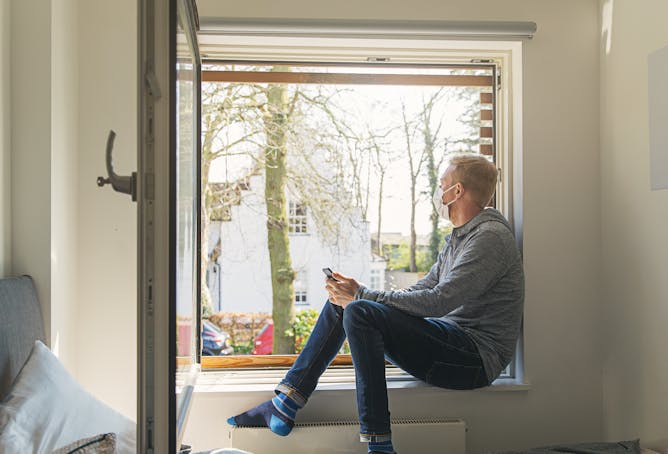|
|
|
|
People’s social lives, for the most part, have moved outside during this pandemic. Compared to being indoors, there is much less risk of catching or spreading the coronavirus at a park or while sitting at a table under the sun. Unfortunately, many of life’s necessities – like school, work, errands and buying groceries – simply have to be done indoors. But there are some easy ways to make indoor spaces safer, and some things to look for that can tell you when a room is a risky place to be.
Shelly Miller, a professor of engineering at the University of Colorado, Boulder, explains how much airflow you need to reduce the spread of the virus, how to measure if a room is getting enough fresh air and how to use air filters to make a room safer if you can’t open a window.
Also today:
|
Daniel Merino
Junior Editor: Science, Health, Environment
|

|
|

Open windows are the simplest way to increase air flow in a room.
Justin Paget / Digital Vision via Getty Images
Shelly Miller, University of Colorado Boulder
Good ventilation can reduce the risk of catching coronavirus. An environmental engineer explains how to know if enough outside air is getting into a room and what do to if ventilation is bad.
|
Arts + Culture
|
-
Karrin Vasby Anderson, Colorado State University
Two researchers viewed all the television series featuring a woman presidential figure, and a remarkably consistent pattern emerged: ambitious fictional female politicians ended up being bad leaders.
|
|
Politics + Society
|
-
John A. Tures, LaGrange College
Internal party rules make it harder to attract independents, who make up about one-third of US voters.
-
Mark Krasovic, Rutgers University Newark
Republicans are free again to recruit poll watchers – four decades after 'ballot security' operations helped steer New Jersey's 1981 gubernatorial race toward their candidate.
|
|
Ethics + Religion
|
-
Kathryn Barush, Santa Clara University
The pandemic has inspired new forms of pilgrimages – some do-it-yourself, in which people are walking in their backyards or nearby spaces and finding meaning.
|
|
Science + Technology
|
-
Francine Berman, Rensselaer Polytechnic Institute
Self-regulation by the technology industry has failed to keep people safe online. That's a job for government.
-
Parker Crutchfield, Western Michigan University
Rather than a vaccine to beef up your immune system, a psychoactive substance could boost your cooperative, pro-social behavior – curtailing the selfish actions that spur on coronavirus's spread.
|
|
Trending On Site
|
-
Natalie C. Tronson, University of Michigan
Many patients suffering from COVID-19 exhibit neurological symptoms, from loss of smell to delirium to a higher risk of stroke. Down the road, will COVID-19 survivors face a wave of cognitive issues?
-
William Petri, University of Virginia
Some viruses can hide out in the body and reemerge at later times. Which viruses do this, and can the new coronavirus do this too?
-
David C. Barker, American University School of Public Affairs; Sam Fulwood III, American University
It's a myth that Black voters represent monolithic support for Democrats. A recent survey shows that young Black Americans in swing states have big reservations about Joe Biden, Democrats and voting.
|
|
| |
| |
| |
| |
| |
| |
|
|
|
|
|
|
|